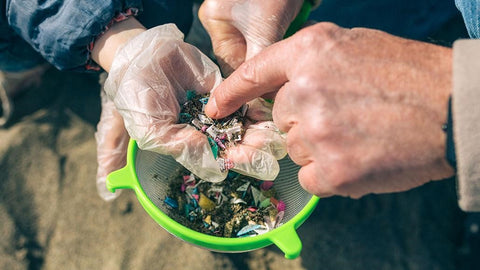MICROPLASTICS: THEMSELVES ARE SMALL, THEIR EFFECTS ARE BIG

Source: Preview
In our new article, we introduce you to the invisible side in the world of plastics: microplastics. Yes, we call it the 'invisible' side because microplastics are very difficult to detect with the naked eye due to their sizes ranging from 5 mm to 1 micrometer . They are in cosmetic products, shampoos and soaps, toothpastes, deodorants; In materials such as polyester and nylon used in textile products; in vehicle tires… And in many other places than we can imagine. Let's dive a little deeper into the subject.

Source: Science News For Students
Let's start with how microplastics are formed: In fact, the starting point of everything is plastics thrown into the trash. Many of these plastics do not decompose in nature for many years, and over time , they break down into small pieces due to various factors (sunlight, light, oxygen, etc.) and mix with various living spaces on our planet. It is possible to divide microplastics into two: primary and secondary microplastics. The first is primary microplastics: plastics produced to be small . For example, many microplastics found in cosmetics, such as synthetic fibers in masks, fall into this category. Then there are secondary microplastics – plastics created by the breakdown of large materials: pieces of plastic bottles and plastic bags, nets, ropes and even the fibers of our synthetic clothes.
Consider that 70 million tons of fibers are used in the clothing industry every year , and 60% of these 70 million are synthetic. This means that 60% of the clothes produced leave countless microplastics behind every time they are washed, which will not disappear in nature for many years. To be more specific, that number is exactly 1900 fibers per wash. The picture is not encouraging at all, is it?

Source: Sourcing Journal
Of course, when we look at it from a broader perspective, it is possible to talk about many more damages caused by microplastics. These tiny particles , which are especially easy to mix with water and cannot be easily separated after mixing (it is not possible to completely get rid of microplastics even when purifying water!), not only threaten our health, but are also consumed by many marine creatures as food. According to Greenpeace Turkey's 2019 report "Microplastic Pollution in Marine Creatures in Turkey", 44.3% of the fish examined in Turkey contain microplastics. In other words, approximately one in every two fish contains microplastic... According to another study, people consume plastic the size of a credit card every week thanks to what they eat and drink.
In her TEDx talk, “Microplastics Are Everywhere,” Sarah Dudas, a biologist, says: “As scientists, when we look at habitats and the environment, we see that microplastics are everywhere: in different habitats – from freshwater to the ocean, from the deep sea to the Arctic, to animals – up the food chain.” from the bottom and zooplankton and fish to the top, marine animals and even us. Microplastics are everywhere, and as animals eat these plastics, they can have negative effects. Physical effects can create clogging, corrosion, or chemical effects from plastics or chemicals in the environment and waste adhering to plastics. “All of these can have negative health effects: reduced growth and reproduction.”

Source: Indie and Isaac
Dudas' suggestion to reduce the formation of microplastics is to adopt and implement the reduce - reuse - recycle cycle in all areas of life. However, at this point he makes an addition and adds the "reject" rule to this cycle: "Reject single-use plastic, every plastic that is not needed, reject straws, reject coffee cups..." Can't it be rejected? Then it is necessary to reduce it. Reducing it is possible by carefully considering the plastics we do not really need and turning to natural alternatives. Can't it be reduced? Then the solution is to reuse it. Here too, we see again and again the importance of quality, durable and long-lasting products. We understand the value of high-quality, luxury vintage products, because each of them is an 'investment in the future and nature'... If we cannot reuse, there is still an alternative: recycling... You see, there are many alternatives. It's the intention that matters. Our intention is very clear: to slow down fast fashion and focus on little and essence. We can make it all possible with a few changes in our linear way of thinking. All together…

